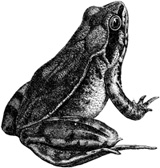Aquatic Communities - Teacher's Guide |
Episode Overview In the first segment, Patrice looks at life in lakes, streams, and wetlands. Next Patrice and Dave look at a snapping turtle. Then we take an up-close look at wetlands. Finally, Marissa and Benjamin join biologist Beth Malcolm and help inspect the growth of animal and plant life in a wetland environment. In the first segment, Patrice looks at life in lakes, streams, and wetlands. Next Patrice and Dave look at a snapping turtle. Then we take an up-close look at wetlands. Finally, Marissa and Benjamin join biologist Beth Malcolm and help inspect the growth of animal and plant life in a wetland environment.
Program ObjectivesStudents will:1. Will understand that environments support a diversity of living organisms and that they all share limited resources. 2. Describe how freshwater life varies depending on a variety of factors like temperature and water motion. 3. Describe adaptations exhibited by freshwater life. Vocabulary
Previewing ActivityHave students name some freshwater communities in their area like lakes, ponds, rivers, streams and marshes. Post-Viewing Activities1. Have students do a "wetland" survey of the school yard. Ask them to identify areas of the school yard that they think will hold water for a short period of time after it rains. 2. Have students research their area and find out what their local watershed is and what issues face it. 3. Using a local map, have students identify local freshwater communities. |
Hands-On:Water PowerIn this episode of NatureWorks, students learned about aquatic environments. In this activity students will learn how the movement of rivers can change the landscape. Materials NeededCoffee can and lid ProcedureDivide class into groups of 3-5 students. Give each group a coffee can and lid and a handful of rocks. Place the rocks in the can and fill the can with enough water to cover the rocks. Have each student in the group shake the can for about a minute. After each student has had a turn shaking the can, have students take the lid off and examine the water. Is it still clear or are there now pieces of rock in the water? How is this similar to and different from what happens in rivers. Additional ResourcesWeb Sites National Wetlands Inventory Center Surf Your Watershed |
